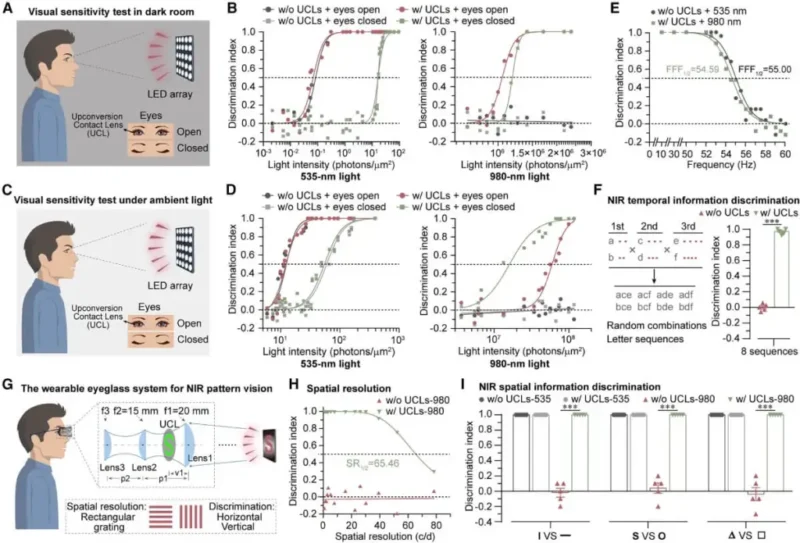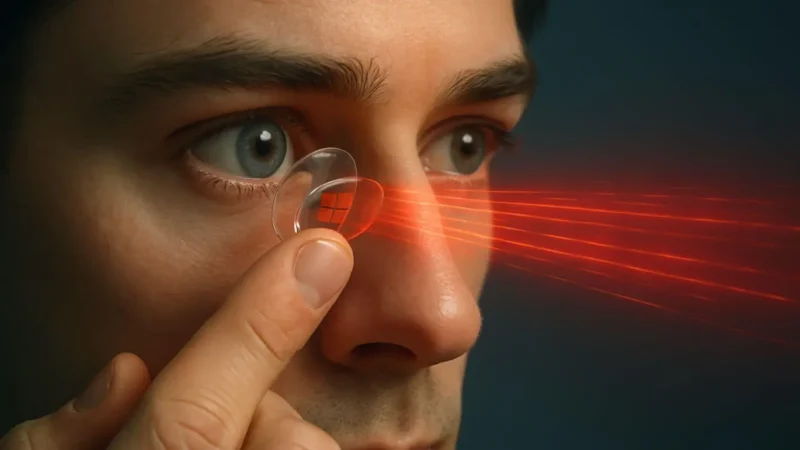It’s nighttime. You are in a place without light, with your eyelids closed. Still, you distinguish shapes, lights, movements. It’s not a fantasy or a weird dream. It’s what some human volunteers have been able to do thanks to an experimental contact lens that transforms human vision like never before. This innovation doesn’t come from science fiction, although it could. It comes from a laboratory, from researchers who wondered if we could magnify what our eyes are capable of perceiving.
The breakthrough has been published in the journal Cell and has quickly captured international attention. The reason: it is a soft contact lens, without battery or wires, capable of providing humans with infrared vision, to see beyond the visible spectrum. And the most surprising thing: it works even when the eyes are closed, thanks to the ability of infrared to pass through the eyelids. In other words, it turns the user into a kind of sensory superhero.
How a lens that sees the invisible works
The development is based on a complex optical principle: the conversion of infrared light into visible light by means of special nanoparticles. These lenses, called UCLs (Upconversion Contact Lenses). Integrate nanoparticles embedded in soft polymeric materials. According to the researchers, particles with a core of sodium fluoride and gadolinium doped with erbium, ytterbium and gold were synthesized. These particles absorb infrared light (between 800 and 1600 nanometers) and convert it into visible light (380 to 750 nm).
What is revolutionary here is not only the conversion, but the fact that it is done inside a soft, comfortable, transparent and safe contact lens for the human eye. According to the study, UCLs achieve an optical transparency of more than 90 %. Allowing natural vision to remain unimpaired. Unlike other night vision devices, these lenses do not require external energy. Since the light transformation occurs within the materials themselves.
Mice and humans: first subjects with monitoring
Before reaching the human eye, testing began in mice. In a series of experiments, the animals were fitted with contact lenses that covered their sutured eyes. Even with their eyes closed, the mice reacted to light stimuli in the infrared spectrum: their pupils contracted and their brains showed visual activity detected on electroencephalograms.
These results were followed by human trials. Several volunteers participated in perception experiments in darkened rooms. With the contact lenses in, they were able to detect flickering infrared light patterns. But what was most surprising was that, when they closed their eyes, infrared sensitivity improved, while visible light vision disappeared. This is because infrared light passes through the eyelids better than visible light, reducing the “visual noise” of the environment.
Infrared color: the missing dimension
One of the technical milestones of the project was to achieve color infrared vision. To achieve this, the team developed a contact lens variant called tUCL (trichromatic UCL). These lenses use more complex nanoparticles that convert different bands of the infrared spectrum into the three primary colors: red, green and blue. Thus, wearers can distinguish different infrared wavelengths as if they were colors.
This system was evaluated by means of color matching tests. Volunteers adjusted the intensity of different infrared lasers (at 808, 980 and 1532 nm) to match a given color, as if they were mixing visible light. The results were clear: they could generate an infrared color gamut equivalent to that of the visible spectrum, with surprising fidelity.
In addition, these new lenses allowed users to interpret infrared visual codes based on colors and blinks. They were even able to recognize shapes and patterns such as letters or geometric symbols. All thanks to the conversion of invisible light into colorful images.
It’s not magic: it’s optics, chemistry and biocompatibility.
None of this would be possible without extremely precise engineering. The nanoparticles must be exactly the right size and perfectly dispersed in the material. The refractive index between the polymer and the particles must be adjusted to the millimeter so that the lens remains transparent. For this, the researchers turned to polymers such as pHEMA. Already used in commercial contact lenses, but modified to maintain optical clarity even with a nanoparticle loading of 7 %.
In addition, biocompatibility tests were performed on mice. After wearing the lenses for hours and days at a time, no signs of inflammation, cell death or structural alterations in the retina were found. The hydration and flexibility of the material was also found to be comparable to that of a commercial contact lens. In humans, no side effects were reported during the test sessions.
Is this the future of human vision?
Although the results are promising, the technology is not yet ready for commercial use. Currently, contact lenses can only detect intense infrared light, such as that emitted by powerful LEDs. Sensitivity must be improved to be able to sense weaker sources, such as body heat or residual light in natural nighttime environments. In addition, UCLs do not allow for fine detail imaging. As the conversion slightly blurs the direction of the light.
To solve this, the authors of the study have designed an additional system: glasses with special lenses that concentrate the infrared image before it reaches the lens, thus improving the spatial resolution. This is a further step towards full integration between optical technology and human perception.
Beyond vision in the dark, the researchers highlight other applications: detection of encrypted signals, aiding people with color blindness, invisible communications, and rescue in extreme conditions. In the words of the original article, “our work confirms that human monitoring capability can be achieved by means of portable nanomaterials”.
With information from Eugenio M. Fernández Aguilar
References: -Yuqian Ma, Yunuo Chen, Sheng Wang et al. Near-infrared spatiotemporal color vision in humans enabled by upconversion contact lenses. Cell, Vol. 188, 2025, pp. 1-14. https://doi.org/10.1016/j.cell.2025.04.019.
Translated by Aliani Rojas Fernandez
- Cuba Reduces HIV/AIDS Mortality - 29 de November de 2025
- FIHAV 2025 Concludes with Cuba’s Economic Highlights - 29 de November de 2025
- Non-Violence’s Day: A Commitment That Unites Us - 29 de November de 2025

